i'm totally overthinking this
I have no quote for the title of this one, which I suppose fits in a it's-Monday-and-I-might-as-well-be-a-lump-of-stone kind of way. I cannot brain today. Anyway, beneath the cut is a short meta tracing the visual trope of the statue in Supernatural.
There are a few visual tropes that repeatedly come up around the angels in Supernatural. One, for example, is overhead lights (electricity) and the interplay of light and shadow. One that comes up less, but which has been around since Season 2 and Houses of the Holy (2x13), is statues; a connection that the show makes explicit in Season 4 in Heaven and Hell with Anna's line characterizing the angels as "cold and emotionless, like marble statues."
By the way, I don't think this means they actually lack emotions. Zachariah certainly gets angry, as did Uriel, and in the right circumstances we've seen plenty of emotion boiling beneath Castiel's surface. I understand this to mean that they keep them tightly controlled. I suspect that maybe after a few thousand years of unrelenting calm and controlled angel-ness, Anna was climbing the figurative walls.
But that's another discussion. Here I'm planning to track the appearances of statues when connected with angels in the show.
So, Houses of the Holy featured a number of angel icons:
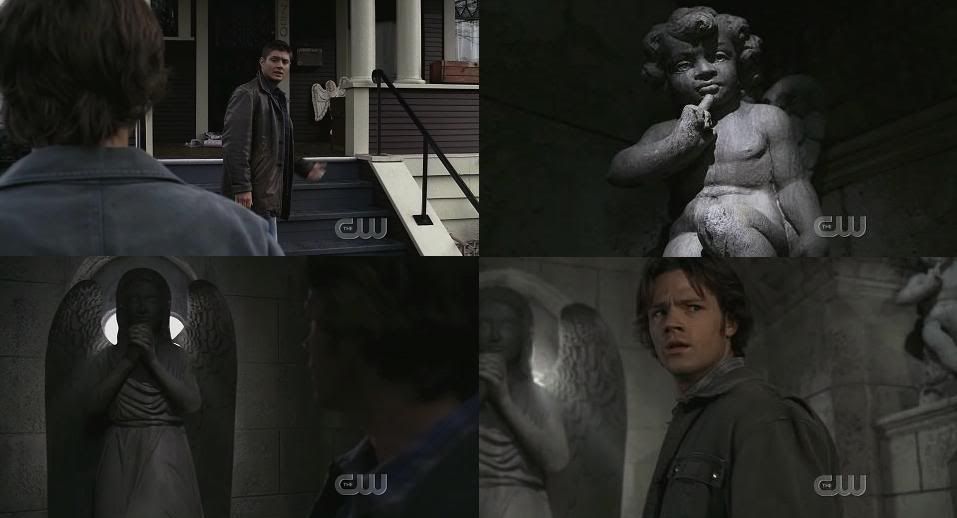
(No, no, not Jensen and Jared. Though they are ~divine~.)
Of course, the angel in HotH was a false one; we know it was the ghost of the minister. But he did foreshadow the real angels and their attitudes, oddly enough; he, too, was willing to use people and sacrifice people (and to push them into murder) to stamp out evil and create a better world. Or, his version of Paradise. Interestingly, while it's Sam who, though faithful, sees the false angel, it's Dean who sees the one-in-a-million death of the would-be rapist and is left wondering if it means there really might be angels (and all that implies).
Total aside: I am oddly disappointed by the lack of Madonnas-on-the-half-shell in HotH. Believe me, for kitschy religious garden decor that's exactly how we roll in New England.
This episode is also the first time (I think?) we see a painting with Michael defeating Lucifer, the same scene we see in another painting in the green room, two seasons later.
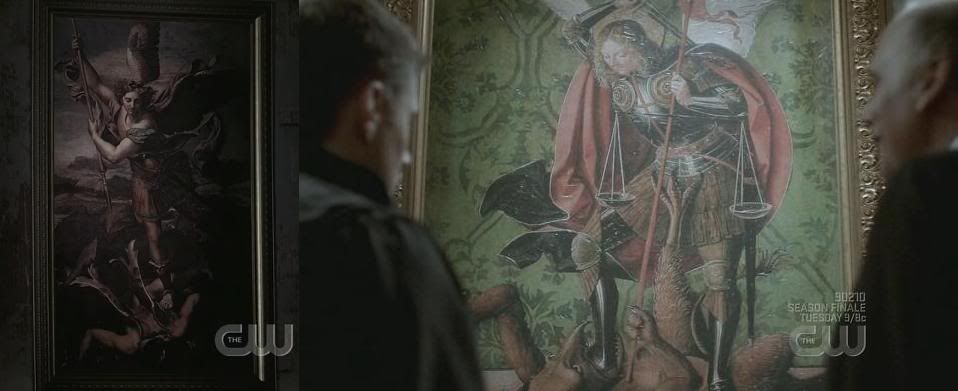
Statues and angels pop up again in Season 4, next in I Know What You Did Last Summer (4x09).

The statue in the church attic is of the Virgin Mary (so, not strictly an angel) but a common church statue (and Mary's place in the mythology of the show is pretty clear). I think this is the only time we see something like a statue crying tears of blood? The contrast of the very red blood against the very white statue struck me then, and now makes me think of the white suit and red rose from The End. There's also a stained glass window of Michael in the background, (which I've banged on about before), between the statue and Dean.
Then, there's lingering shot of this angel statue in St. Mary's convent from Lucifer Rising (4x22).
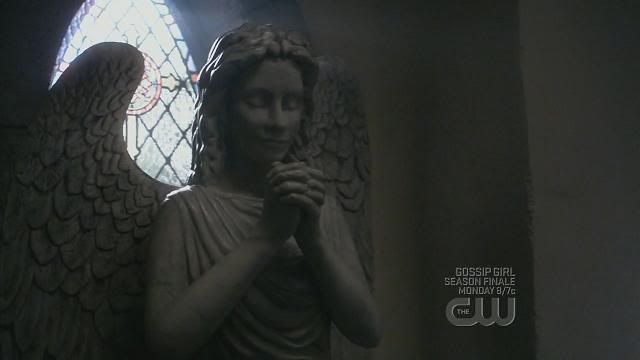
(I'm pretty sure that statue was also in Houses of the Holy.)
And (my favorite), also from 4x22: Dean being Dean.
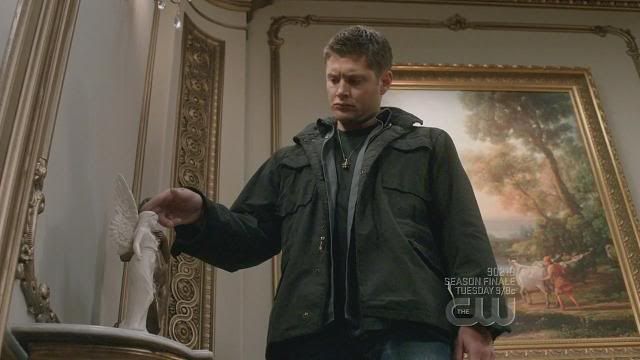
That last one I love in light of Anna's speech. In that image, I see Dean doing what Dean does--taking that carefully constructed work (the cool distance, the unassailable control--not to mention the long-term plan) and smashing it to bits.
And finally, the image that got me thinking about this, from The End (5x04).
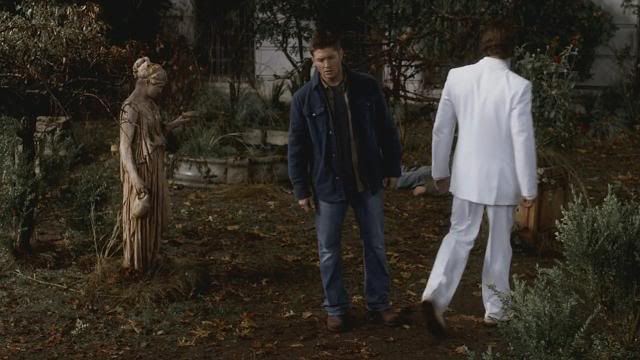
I know: not an angel. But the statue is so prominently placed that it seems the viewer is intended to be aware of it. I'm wondering why it's there? A hint this is another construct of Zachariah's (she's all draped in the kind of classical robes you see in some of the paintings from the green room, is the kind of piece that fits with the green room's aesthetic)? A symbol of the idealized past, the now-oddly-better days when they were just monster hunters with a mission, before they learned so much (significant that they are in a ruined Garden)? Does it represent the pastoral ideal put forth by the angels (Paradise) that with Dean's refusal to become Michael's vessel is then lost? A reference to this?
When the statues pop up around angels, they also seem to appear in situations that are not what they seem--false angels, false icons, false idols. The minister is a false angel, Anna's a fallen angel, Zachariah is hiding the whole truth from Dean, and in St. Mary's, Sam's duped into releasing the most infamous fallen angel of them all. So what do you think? Are they another warning sign, or do they stand in for the loss of innocence, loss of paradise? Maybe both.
There are a few visual tropes that repeatedly come up around the angels in Supernatural. One, for example, is overhead lights (electricity) and the interplay of light and shadow. One that comes up less, but which has been around since Season 2 and Houses of the Holy (2x13), is statues; a connection that the show makes explicit in Season 4 in Heaven and Hell with Anna's line characterizing the angels as "cold and emotionless, like marble statues."
By the way, I don't think this means they actually lack emotions. Zachariah certainly gets angry, as did Uriel, and in the right circumstances we've seen plenty of emotion boiling beneath Castiel's surface. I understand this to mean that they keep them tightly controlled. I suspect that maybe after a few thousand years of unrelenting calm and controlled angel-ness, Anna was climbing the figurative walls.
But that's another discussion. Here I'm planning to track the appearances of statues when connected with angels in the show.
So, Houses of the Holy featured a number of angel icons:

(No, no, not Jensen and Jared. Though they are ~divine~.)
Of course, the angel in HotH was a false one; we know it was the ghost of the minister. But he did foreshadow the real angels and their attitudes, oddly enough; he, too, was willing to use people and sacrifice people (and to push them into murder) to stamp out evil and create a better world. Or, his version of Paradise. Interestingly, while it's Sam who, though faithful, sees the false angel, it's Dean who sees the one-in-a-million death of the would-be rapist and is left wondering if it means there really might be angels (and all that implies).
Total aside: I am oddly disappointed by the lack of Madonnas-on-the-half-shell in HotH. Believe me, for kitschy religious garden decor that's exactly how we roll in New England.
This episode is also the first time (I think?) we see a painting with Michael defeating Lucifer, the same scene we see in another painting in the green room, two seasons later.

Statues and angels pop up again in Season 4, next in I Know What You Did Last Summer (4x09).

The statue in the church attic is of the Virgin Mary (so, not strictly an angel) but a common church statue (and Mary's place in the mythology of the show is pretty clear). I think this is the only time we see something like a statue crying tears of blood? The contrast of the very red blood against the very white statue struck me then, and now makes me think of the white suit and red rose from The End. There's also a stained glass window of Michael in the background, (which I've banged on about before), between the statue and Dean.
Then, there's lingering shot of this angel statue in St. Mary's convent from Lucifer Rising (4x22).

(I'm pretty sure that statue was also in Houses of the Holy.)
And (my favorite), also from 4x22: Dean being Dean.

That last one I love in light of Anna's speech. In that image, I see Dean doing what Dean does--taking that carefully constructed work (the cool distance, the unassailable control--not to mention the long-term plan) and smashing it to bits.
And finally, the image that got me thinking about this, from The End (5x04).

I know: not an angel. But the statue is so prominently placed that it seems the viewer is intended to be aware of it. I'm wondering why it's there? A hint this is another construct of Zachariah's (she's all draped in the kind of classical robes you see in some of the paintings from the green room, is the kind of piece that fits with the green room's aesthetic)? A symbol of the idealized past, the now-oddly-better days when they were just monster hunters with a mission, before they learned so much (significant that they are in a ruined Garden)? Does it represent the pastoral ideal put forth by the angels (Paradise) that with Dean's refusal to become Michael's vessel is then lost? A reference to this?
When the statues pop up around angels, they also seem to appear in situations that are not what they seem--false angels, false icons, false idols. The minister is a false angel, Anna's a fallen angel, Zachariah is hiding the whole truth from Dean, and in St. Mary's, Sam's duped into releasing the most infamous fallen angel of them all. So what do you think? Are they another warning sign, or do they stand in for the loss of innocence, loss of paradise? Maybe both.